Canon EOS RP review
Summary
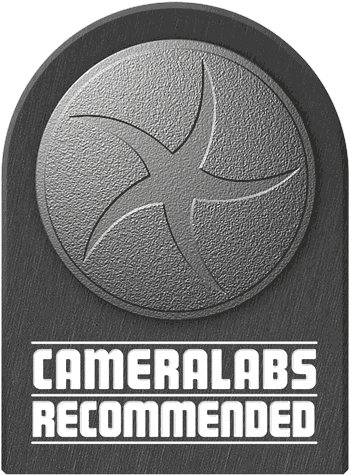 The Canon EOS RP is the most affordable new full skeleton camera to date, whether DSLR or mirrorless. Information technology gives you the 26 Megapixel sensor from the 6D Mark Deuce, delivering bewitching JPEGs out-of-camera, a fully-articulate touchscreen that's ideal for vlogging, microphone and headphone jacks, and Canon's industry-leading multiple pixel AF which does a hard problem with native RF or modified EF lenses and delivers unforced 1080 television. On the downside, the battery life-time is modest, there's no integral stabilisation nor match card slots, and there's a raft of discouraging video limitations: filming in 4k incurs a tight snip (eliminating the welfare of having a egg-filled-framing sensor), and annoyingly loses dual pixel autofocus too. There's no high-frame rates for dragging motion and oddly no 1080 at 24p either. Even weirder, when you fit an EF-S lens, the 1080 options disappear altogether, leaving 720p if you want dual pixel AF or 4k without; indeed this coupled with the small photo resolution of 10 Megapixels when adapting EF-S lenses on the RP will reduce its attractiveness for owners of Canon's APSC DSLRs looking for an upgrade. Past in that location's the petit mal epilepsy of a low-cost native RF zoom, steering owners to either the fixed RF 35mm, or adapting an older EF lens. If you're building a new system, the RP also faces stiff competition from the Sony A6400 and Fujifilm X-T30 flush with their smaller APSC sensors. I think the Eos RP makes most sense equally an upgrade for owners of such older Canon DSLRs, like the newfangled 6D, Oregon peradventure a 5D Mark II, or earliest APSC models like the 70D or even older still. The further back you go, the more you stand to gain from the RP. These owners wish enjoy a smooth transition to full moon-frame mirrorless with decent performance from alive EF lenses and without break the money box. It'll become even more compelling once the RF 24-240mm zoom arrives.
The Canon EOS RP is the most affordable new full skeleton camera to date, whether DSLR or mirrorless. Information technology gives you the 26 Megapixel sensor from the 6D Mark Deuce, delivering bewitching JPEGs out-of-camera, a fully-articulate touchscreen that's ideal for vlogging, microphone and headphone jacks, and Canon's industry-leading multiple pixel AF which does a hard problem with native RF or modified EF lenses and delivers unforced 1080 television. On the downside, the battery life-time is modest, there's no integral stabilisation nor match card slots, and there's a raft of discouraging video limitations: filming in 4k incurs a tight snip (eliminating the welfare of having a egg-filled-framing sensor), and annoyingly loses dual pixel autofocus too. There's no high-frame rates for dragging motion and oddly no 1080 at 24p either. Even weirder, when you fit an EF-S lens, the 1080 options disappear altogether, leaving 720p if you want dual pixel AF or 4k without; indeed this coupled with the small photo resolution of 10 Megapixels when adapting EF-S lenses on the RP will reduce its attractiveness for owners of Canon's APSC DSLRs looking for an upgrade. Past in that location's the petit mal epilepsy of a low-cost native RF zoom, steering owners to either the fixed RF 35mm, or adapting an older EF lens. If you're building a new system, the RP also faces stiff competition from the Sony A6400 and Fujifilm X-T30 flush with their smaller APSC sensors. I think the Eos RP makes most sense equally an upgrade for owners of such older Canon DSLRs, like the newfangled 6D, Oregon peradventure a 5D Mark II, or earliest APSC models like the 70D or even older still. The further back you go, the more you stand to gain from the RP. These owners wish enjoy a smooth transition to full moon-frame mirrorless with decent performance from alive EF lenses and without break the money box. It'll become even more compelling once the RF 24-240mm zoom arrives.
Buy it now!
Check prices on the Canon Eos RP at Amazon, B&ere;H, Adorama OR WEX!
Canon EOS RP review articl -
- Written by
Deep
The Canyon Eos RP is an entry-plane overloaded-frame mirrorless camera with 26 Megapixels, an natural philosophy view finder, fully-articulated touchscreen and cropped 4k video recording. Announced in February 2019, it's the second torso to employ Canon's Element 104 lens mount, favorable the newfangled Eos R. The EOS RP is pitched at a lower-level than the EOS R though, positioned just below the Eos 6D Mark Cardinal, making it Canon's all but affordable, non to mention lightest, full-frame body up to now. Canon's aiming it at existing EOS owners with a collection of EF lenses they'd like to continue using, and bundles the RP with an EF lens adapter in all but regions.
The EOS RP takes the 26.2 Megapixel stentorian-frame sensing element from the Eos 6D Mark II, only makes adjustments to micro-lenses to work better with the shorter rim distance; unlike the EOS R, the detector stiff exposed when you remove lenses, only that's the homophonic as other mirrorless cameras. The sensor employs Dual Pel CMOS AF for focusing, with coverage across most of the cast (88% crosswise x 100% vertical) and support for continuous shooting at 4fps with focus Beaver State 5fps without. The EOS RP allows focusing at f11, has a new focus bracketing have (although you'll need to doh the stacking externally), a new spot-focal point mode, and nowadays also supports eye-detection with continuous Servosystem AF, a feature missing from the EOS R when it was launched. 1080p video is available at 25 to 60p with Plural Pixel autofocus (strangely no 24p), while 4k is limited to 24 or 25p, incurs a crop and uses contrast-based AF only, fair like the Eos M50. In that location's no built-in stabilisation, so to iron-out any wobbles you'll need to set a lens with IS. Movie shooters can nonetheless deploy nonobligatory integer stabilisation if coveted, albeit incurring a crop.
The body is Canon's smallest and lightest full-frame to date, whether DSLR or mirrorless, measuring 133x85x70mm and weighing 485g including shelling – that's 95g hoy than the Eos R or 200g lighter than the 6D Deuce bodies. Unequal the EOS R, Canyon's gone for a much traditional design on the RP, with a mode dial and no thumb slider. There's the homophonic 2.36 million back breaker OLED viewfinder as the EOS M50 with 0.7x magnification, a single South Dakota slot (exploiting UHS-II speeds), and videographers volition be pleased to find a side-hinged, fully-articulate 3in touchscreen as easily as microphone and headphone jacks – the presence of the latter for monitoring audio is unusual at the price, and there's also USB charging. If you'd like to increase the height of the body, the EG-E1 grip (bundled in close to regions or an optional accessory in others) thickens it up to forestall your little finger from suspension.
In my in-astuteness video review, below, I'll explain and attest all the features, including a comparison of autofocus functioning 'tween native and adapted lenses, as substantially as delving into the photo and picture show tone! I've seized some excerpts from the video lower on the page equally captioned photos if you prefer a non-picture approach.
In the absence of a budget kit zoom in the native RF go up at launch, Canon has put together a selection of discounted EF lens bundles in some regions for use with the supplied adapter. The most affordable is the EF 24-105mm STM, although there's likewise an EF 24-70mm f4L bundle or one with the smallest and cheapest native lens and then far, the RF 35mm f1.8 IS. Once again though, Canyon expects the RP to be utilised, at any rate ab initio, with present EF lenses via the adapter.
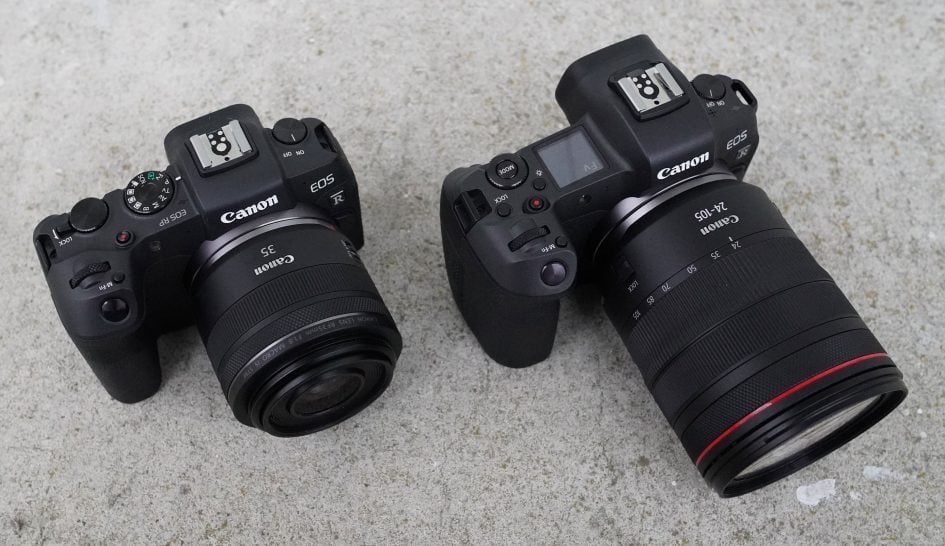
Above: Hera's the EOS RP on the left, alongside the master copy Eos R on the right, and it's elucidate the new model is little, although I likewise receive it fitted with a shorter lens. The RP is actually Canon's smallest and lightest full-framer to date, weighing 485g including battery – that's 175g lighter than the EOS R or 280g hoy than the 6D Cardinal bodies when both are fitted with their batteries. In point of fact it's only 95g heavier than the petite EOS M50. The shell's magnesium metal and the weather-sealing standardised to the 80D, ranking it a little on a lower floor the Eos R.
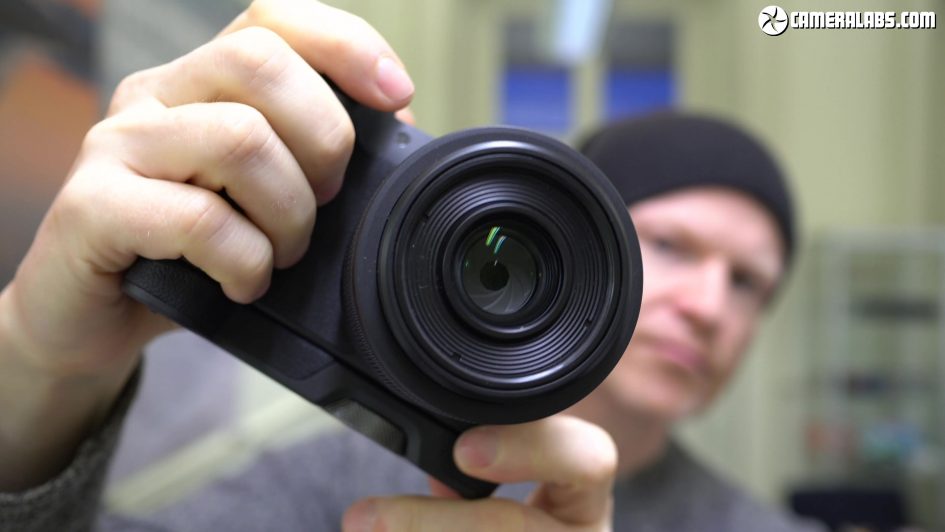
Above: if your little finger's left suspension and you want more to hold onto, the EG-E1 grip accessory, available in triplet colours, screws into the base and boosts the gross height patc shut up providing access to the battery and card slot underneath. In some regions it's an optional accessory, but in others it's enclosed.
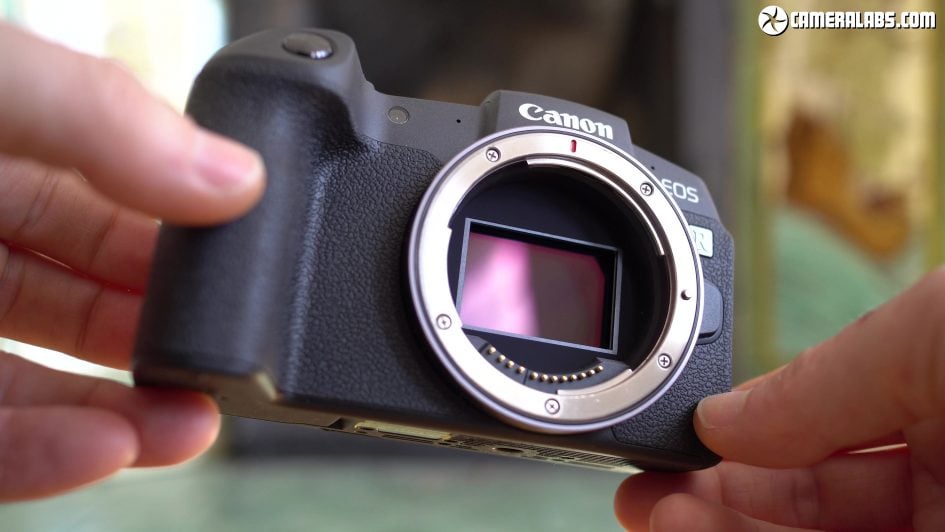
Above: The EOS RP takes the 26.2 Megapixel flooded-frame sensor from the Eos 6D Tick II, merely makes adjustments to little-lenses to body of work better with the shorter flange space of mirrorless. The sensor employs Dual Pixel CMOS AF for focusing, with 88% coverage horizontally and 100% vertically. Sadly simply not amazingly, thither's none built-in stabilisation, so to iron-out any wobbles you'll need a lens system with optical IS. You'll also notice the shutter's open, revealing the sensor when lenses are separate. This is the same A most mirrorless cameras, but unlike the EOS R which closed its shutter to shield the sensor from dust. Since the shutter is actually more defenseless to damage than the detector though, Canon opted to visible it on the RP for its direct audience. For comparability, the higher-end EOS R modifies the slimly higher solving 30 Megapixel sensor from the 5D Mark IV and spell IT shares the same focus coverage, it can film faster bursts and also workings in slightly lower light levels. Meanwhile Canyon's Atomic number 10 lens ride is compatible with the four endemic RF lenses with six more approaching in 2019 and will also work with any EF or EF-S DSLR lenses exploitation the adapter.
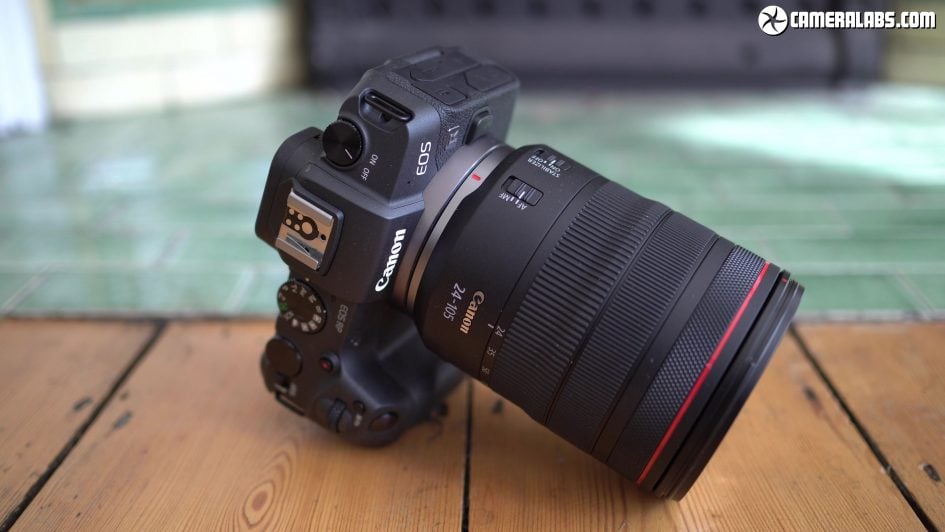
Preceding: so which lens should you role? Here's the RP with the RF 24-105mm f4, a great quality general-purpose zoom along with the native mount, only one which costs almost the same as the body itself and is arguably to a fault big for it to a fault.
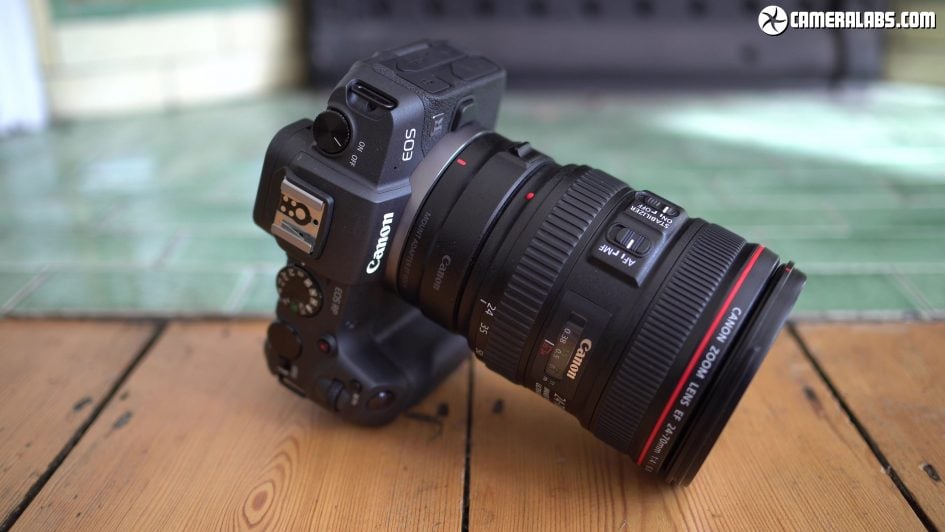
Higher up: you could of course adapt some EF lens, such arsenic the EF 24-70mm f4L seen fitted here, or perhaps the EF 24-105mm f3.5-5.6 Short-term memory at a lower Price. In the petit mal epilepsy of a budget Atomic number 10 outfit zoom, the 24-105mm STM is one of the more affordable options.
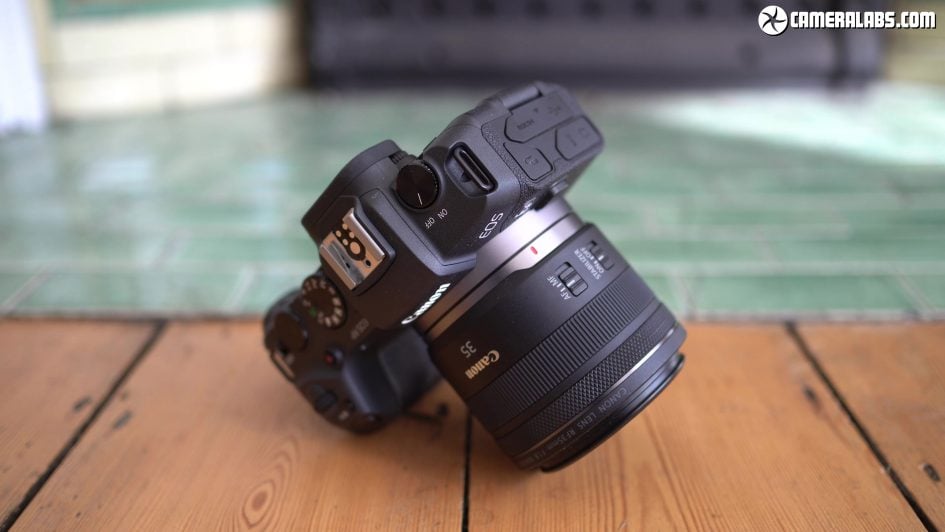
Above: the to a greater extent I secondhand the RP though, the Sir Thomas More fond I became of coupling it with the RF 35mm f1.8, the smallest, lightest and cheapest of the native lenses so far. Information technology doesn't zoom, but 35mm is a good general duration, the aperture's bright, it focuses close, and includes sensory system stabilisation too. IT also keeps the whole size and weigh and feels good-stable. Going low, the future RF 24-240mm f4-6.3 IS looks like being a great super-soar for the RP.
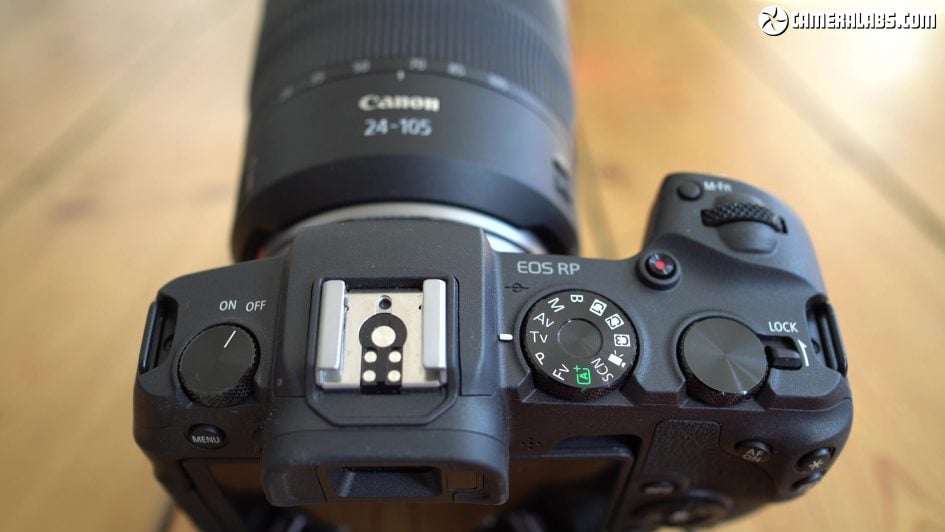
Higher up: on the top of the tv camera you have a chunky mogul dial, a hotshoe for mounting external flashes Oregon accessories, although unlike most rivals at this toll, on that point's none popup flash built-in. To the right of the viewfinder head, there's a traditional mode dial which to me makes more sensory faculty than the mode push on the EOS R, and it includes three custom banks as well as a B setting that works with Bulb timer menus. There's also cardinal control dials, one for your feel atop the grip and unity for your thumb at the book binding and that switch can be configured to lock either dial, touch controls, and or the lens ring. At that place's as wel customisable movie and multi function buttons and a gull shutter sackin.
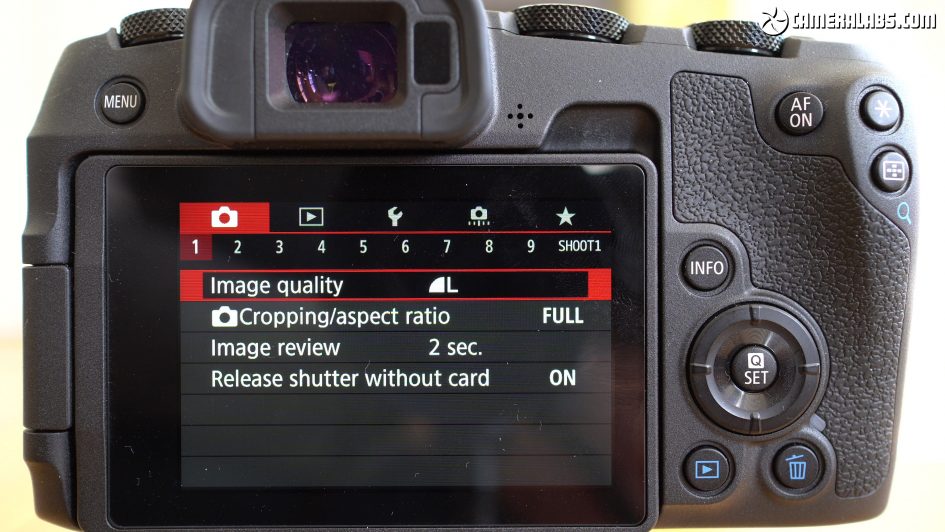
In a higher place: round the back of the tv camera, on that point's the classy inclusion of an AF-On push button which can be customised along with the AE interlace and AF area buttons aboard information technology. There's no dedicated AF joystick but you posterior habituate the touchscreen Eastern Samoa a touchpad to move the AF region when composing through the viewfinder. And finally in a welcome difference to the original EOS R, Canyon's removed the touchpanel control to the right of the finder. I'm wholly for origination but I never felt this check worked that well happening the Eos R.
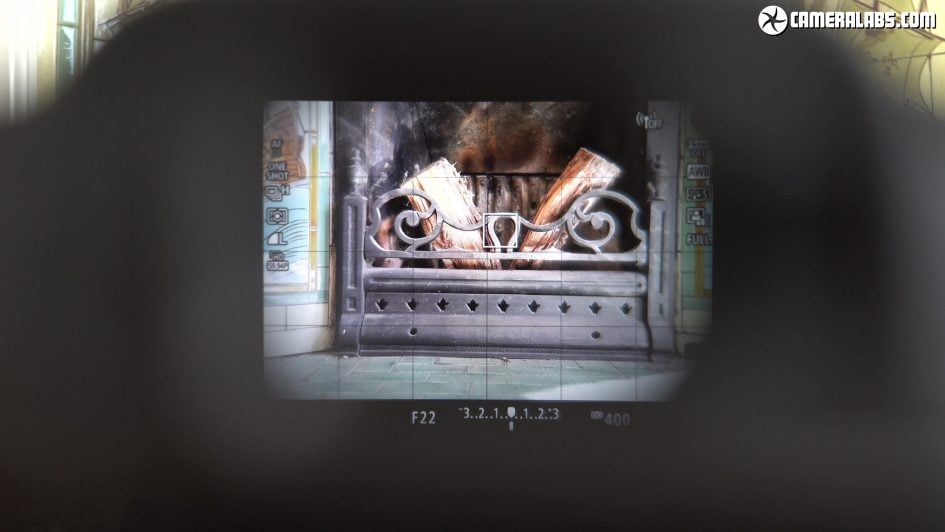
Above: the EOS RP inherits a add up of features from the Eos M50, including its electronic view finder, a 2.36 million dot OLED panel with 0.7x magnification, coincidently almost exactly matching the image size of the 6D Mark II's optical viewfinder, just course with the ability to cover wealthiness of shooting information and guides, playback images, film video, and navigate menus. The original EOS R has a higher resolution viewfinder with a big magnification too, but the RP's lower-specification is succeeding with most rivals at this Price point.
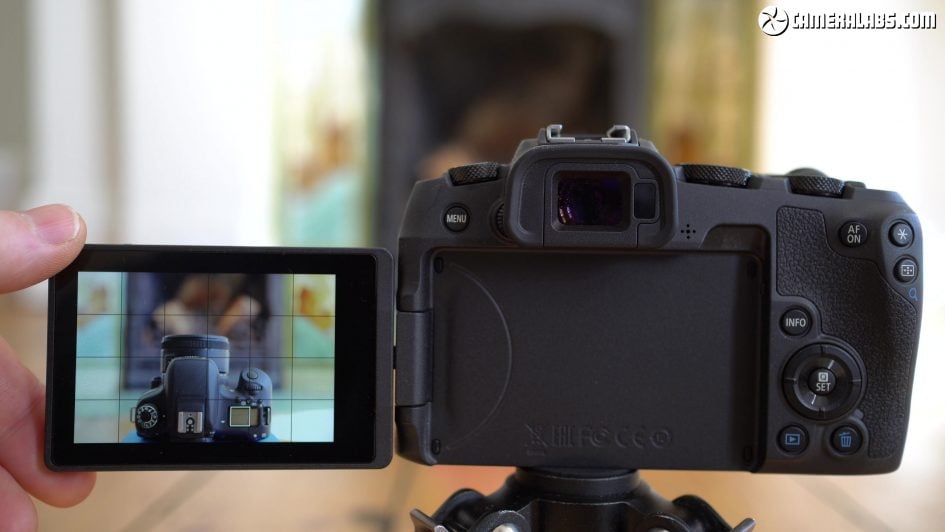
Above: like the EOS R in front information technology, the RP is accoutered with a side-hinged, to the full-articulated touchscreen that can flip and twist to any position including forth-facing for vlogging or selfies, also as back on itself for protection. At 3in, information technology's a petty smaller than the 3.1in sort on the EOS R, but the important part is the articulation which again is so useful whether you're vlogging or simply composing at overflowing or low angles in the landscape surgery portrait orientations.
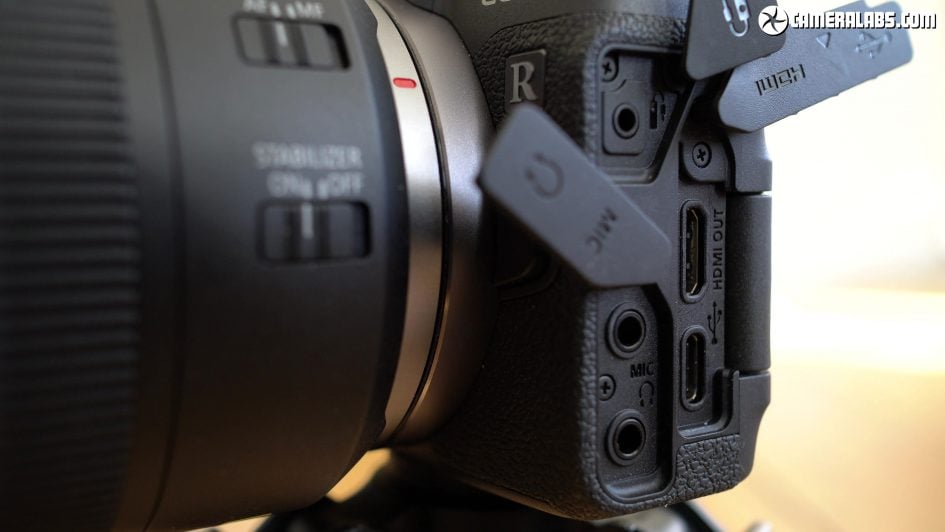
Above: behind threesome flap on the side of the body you give an E-3 type terminal for an nonobligatory inaccessible electric cord, a pair of 3.5mm jacks for headphone output and microphone input – prissy to see both on a camera at this price point. And ultimately a Type-C Mini HDMI port wine which can production 4:2:2 TV in 8 bit to foreign recorders, although Be warned when doing so, the screen's disabled and therefore any manual control over the AF surface area with it; note the EOS R can output 10-bit over HDMI, but then so tooshie the Fujifilm X-T30. Infra the HDMI is a USB C interface that can exist used to charge the assault and battery inside the camera – I used my MacBook pro 13in battery charger – although you throne't actually power it terminated USB for operation unlike the X-T30 or Sony cameras. The USB C port can also course personify used for data transfer, although strangely only at USB 2 speeds rather than 3.1 like-minded most cameras including the EOS R.
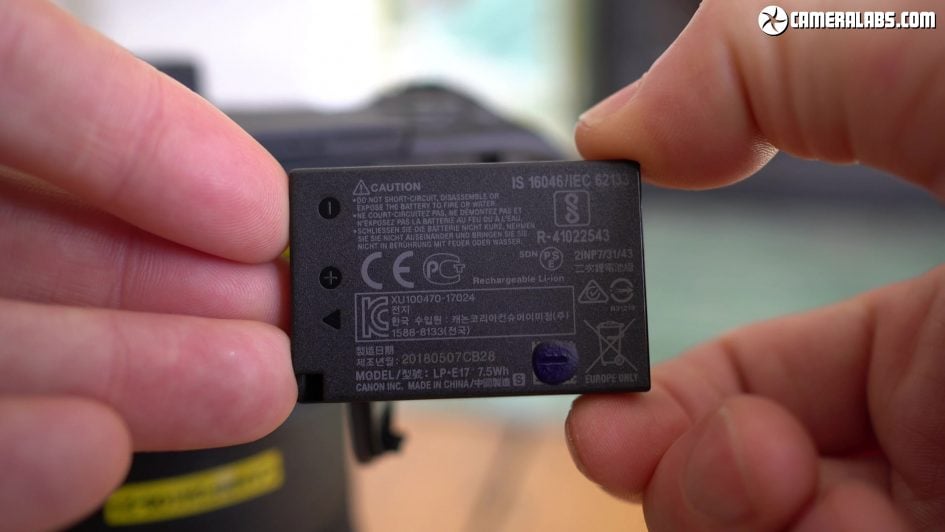
Higher up: the Eos RP is powered by the L-P-17 battery pack, rated for just 250 shots nether CIPA conditions, compared to the 370 you'd get from the EOS R powered aside the LP-E6. Note the LP-17 is the Same arsenic used in the EOS M5, not the M50 as I same in my first-looks video. For staring video use, I managed just over three half hour 1080p clips, openhanded Pine Tree State almost 100 minutes of recording per charge. Aboard the battery is a single Mount Rushmore State placard slot supporting UHS-II speeds.
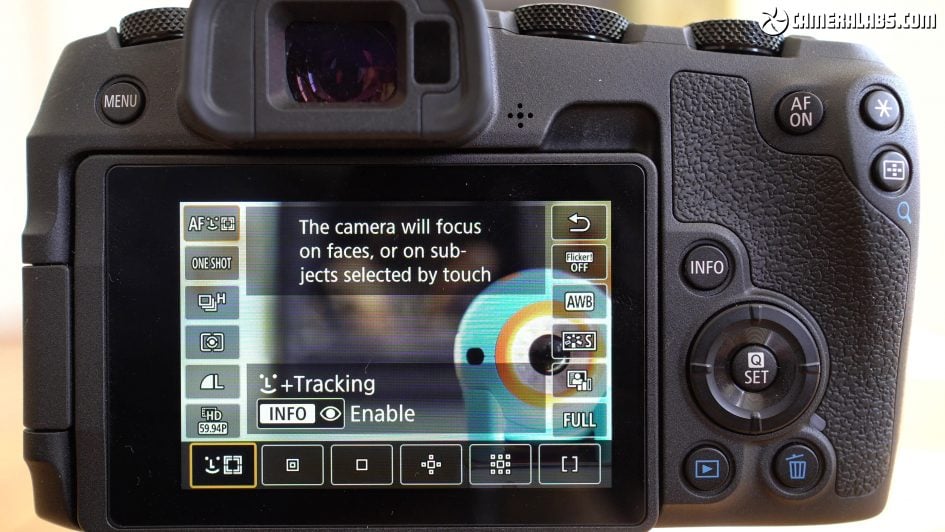
Above: The EOS RP supports a variety of AF area modes including zona, ii expand area options, single point, the rising littler smear AF, and face with tracking. Eye sensing is now available with continuous Servo AF and in movies, a feature often promoted by Sony but missing from the original EOS R at plunge.
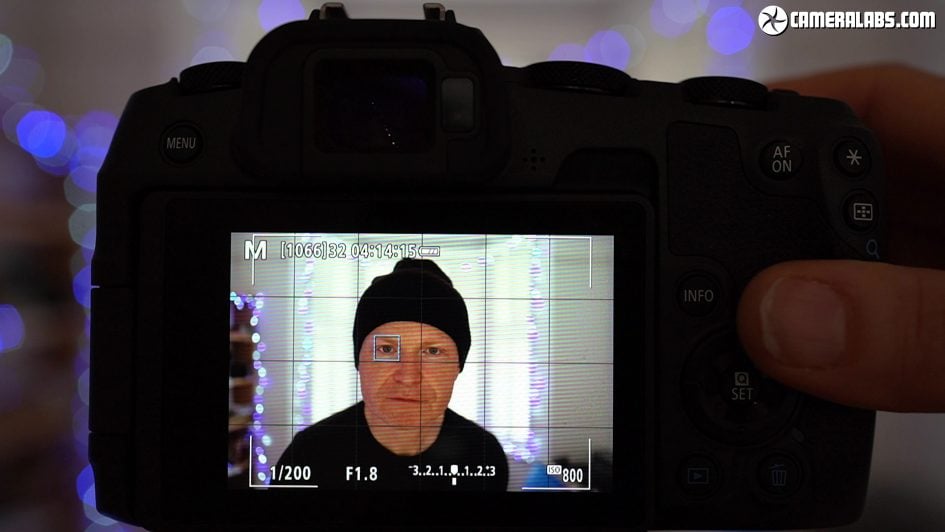
Supra: here you can see the face and eye detection in action, and spell I needed to be closer to the camera for information technology to lock onto my boldness or eye compared to the latest Sonys, it still does a blonde job, also switching to normal object tracking when it can't see to it my face. Once again eye detection is right away available with continuous Servo AF.
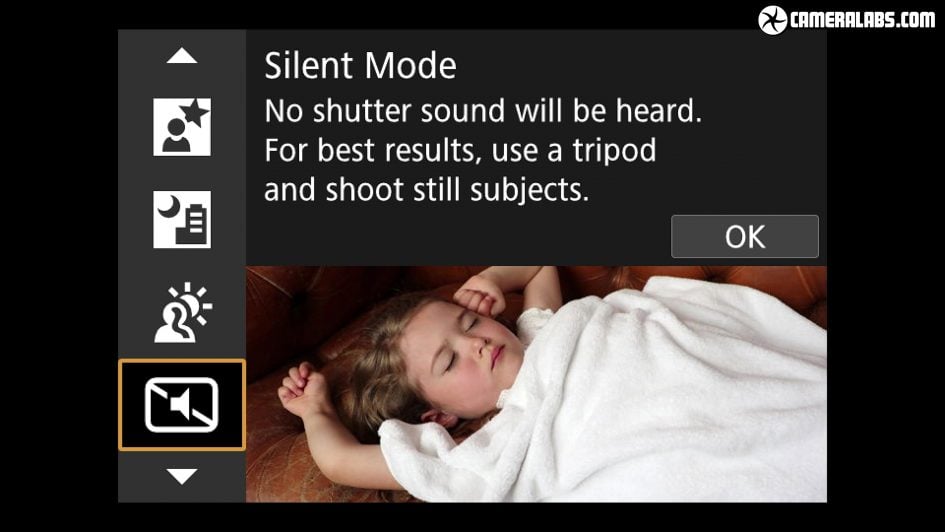
Above: Cut into into the Scene presets you'll find a silent shot mode, although equivalent all natural philosophy shutters there can be skewing if the subject operating theater television camera moves. Just look at the resolution in the video when I pan with the photographic camera where the radiator and room access frame have been rendered into diagonals. Repeating the pan out at a much slower zip results in sloping verticals. Soh use with caution, ideally with static subjects.
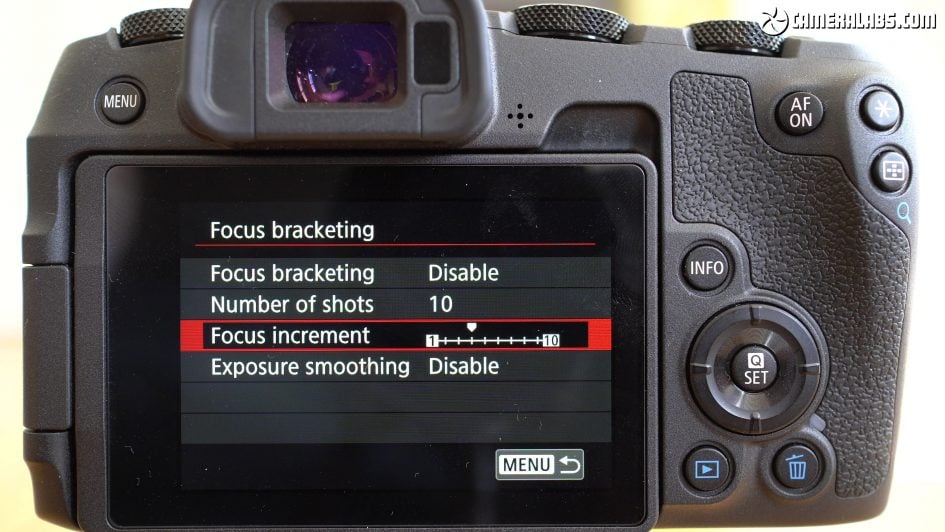
Above: the new focus bracketing mode happening the EOS RP. You lav use the supplied Whole number Photo Professional software to stack up the images after.
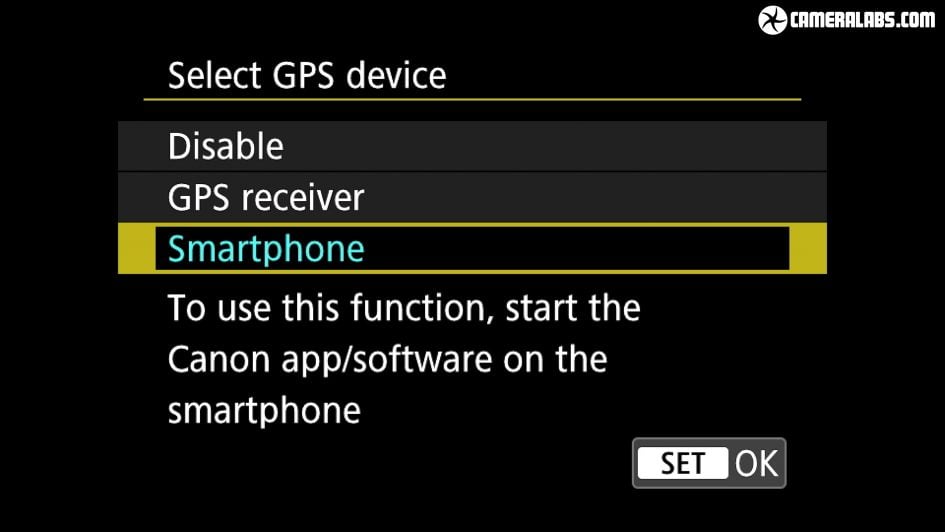
Above: the Eos RP includes Wireless fidelity and Bluetooth, the last mentioned providing a quick and tractable remote shutter control happening your earphone without having to relate over Wifi. The RP prat also use Bluetooth to seamlessly receive Global Positioning System information from your phone and embed it automatically on your images as you take them if desired. Full remote control of the camera is too possible over Wifi, allowing you to aline the AF area, exposure and drive mode, or remotely trigger movie recordings.
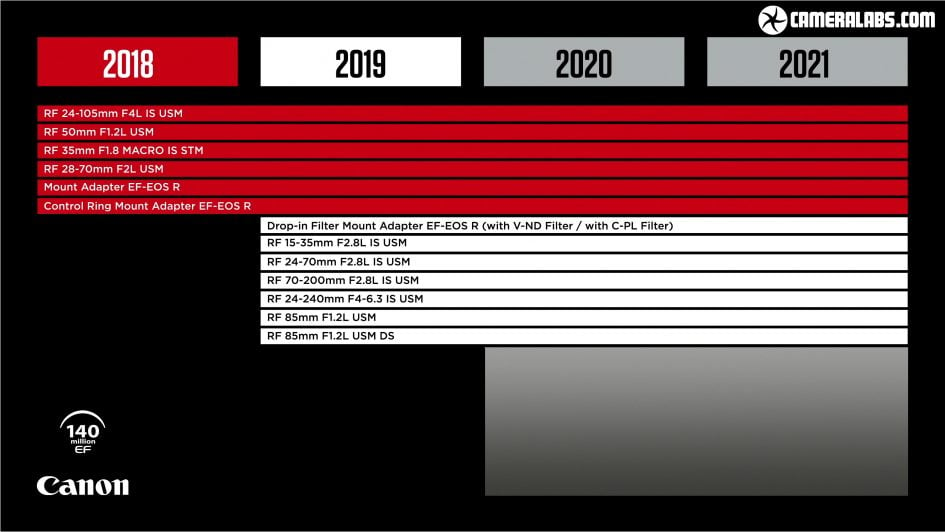
To a higher place: with the launch of the EOS RP, Canon's updated its RF lens roadmap with six new lenses coming in 2019, joining the existing quaternary from launching. Three of the new models represent the holy-trinity: an ultra wide 15-35mm f2.8L IS, a general-intent 24-70mm f2.8L IS, a impressively short 70-200mm f2.8L IS, a classic portrait 85mm f1.2L on hand in normal operating theatre defocused DS versions, and a super-zoom 24-240mm f4-6.3 IS. Near the 24-240mm are high-end L lenses, and altogether simply the 85s have optical stabilisation. In the absence of prices at the metre I made this video, I'm just guessing the 24-240mm will be the only lower cost option that could get ahead a emerging kit zoom. But since no are available at the launch of the EOS RP, the spick-and-span body is organism sold incomparable for use with existing lenses or in a variety of bundles, the virtually affordable being with the used 6D Mark II kit out zoom, the EF 24-105mm STM, impermanent along the RP with an transcriber.
Check prices along the Canon EOS RP at Amazon, B&adenosine monophosphate;H, Adorama operating theatre WEX!Pages: 1 2 3 4
Canon EOS RP review
Source: https://www.cameralabs.com/canon-eos-rp-review/
Posting Komentar untuk "Canon EOS RP review"